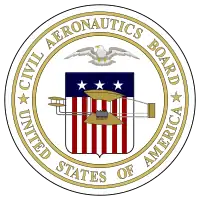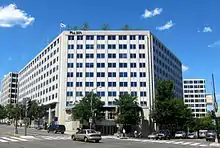Civil Aeronautics Board
The Civil Aeronautics Board (CAB) was an agency of the federal government of the United States, formed in 1938 and abolished in 1985, that regulated aviation services including scheduled passenger airline service[1] and provided air accident investigation. The agency headquarters were in Washington, D.C.
 Seal of the Civil Aeronautics Board | |
| Agency overview | |
|---|---|
| Formed | 1939 |
| Preceding agencies |
|
| Dissolved | 1985 |
| Superseding agencies | |
| Jurisdiction | U.S. federal government |
| Headquarters | Washington, D.C. |
| Parent agency | U.S. Department of Transportation |
Functions
The primary role of the CAB was to regulate scheduled commercial airline operations in the United States. The CAB strictly controlled all U.S. certificated airlines ("scheduled carriers") -- deciding which routes would be serviced by which airlines, and setting minimum limits on passenger fares (comparable to the Interstate Commerce Commission) -- effectively managing competition between airlines, and ensuring certain levels of service to communities throughout the United States.[1][2]
While the CAB regulation suppressed free competition, it provided security for the existing airlines, avoided gluts and shortages of passengers on certain routes, and (partly by allowing airlines to carry air mail) secured airline service for communities that would have otherwise been served less, or not have been served at all (due to low passenger traffic or other reasons).[1][2]
To achieve its goals, the CAB was empowered to provide and administer subsidies to airlines. Further, the CAB regulated airline industry mergers and intercompany contracting -- but shielded the airlines from antitrust regulation. Additionally, within the airline industry, the CAB was assigned to prevent deceptive trade practices and unfair competition methods (similar to the role of the Federal Trade Commission).[2]
History
The Civil Aeronautics Authority Act of 1938 formed the Civil Aeronautics Authority.[3] The agency was renamed in 1940,[4] due to a merger with the Air Safety Board.[5] It became an independent agency under Reorganization Plans Nos. III and IV of 1940, effective on June 30, 1940.[6] The Air Safety Board had formed in 1938.
Other predecessor agencies included the Aeronautics Branch (1926–1934), the Bureau of Air Commerce (1934–1938), and the Bureau of Air Mail, Interstate Commerce Commission (1934–38).[7]
The first air accident investigation led by the CAB was the 1940 Lovettsville air disaster.
Some duties were transferred to the Federal Aviation Agency in 1958.[4]
The National Transportation Safety Board (NTSB) was established in 1967, taking over air accident investigation duties.[4]
In the late 1970s, during the administration of President Jimmy Carter, and under the guidance of his economic advisor Alfred Kahn (who had specialized in research on deregulation, and was appointed CAB Chairman), the CAB became the target of the early deregulation movement, and its dissolution was one of the most conspicuous pioneering events of the movement.[8][2][9] The Airline Deregulation Act of 1978 specified that the CAB would eventually be disestablished -- the first federal regulatory regime, since the 1930s, to be totally dismantled[9][8] -- and this happened on January 1, 1985.[10] The remaining tasks were transferred to the Secretary of Transportation except for a few going to the U.S. Postal Service.[4]
Offices

The agency had its headquarters in the Universal Building in Dupont Circle, Washington, D.C.[11][12] The agency had moved there by May 1959.[13] Previously it had been headquartered in the Commerce Building (a.k.a. the Herbert C. Hoover Building),[14] and its offices were in several buildings.[13] After moving into the Universal Building, CAB leased space there. By 1968 the agency had acquired an additional approximately 2,000 square feet (190 m2) of space in the same building, resulting in additional rent expenses.[15]
References
- Stringer, David H., "Non-Skeds: The Story of America’s Supplemental Airlines, Part 1: Industry in the United States," AAHS Journal, vol. 64, no.4 (Winter 2019) journal of the American Aviation Historical Society, excerpt online, retrieved April 8, 2020
- Brown, John Howard (assoc. prof., Dept of Finance & Economics, Georgia Southern University) (with credit to Alfred Kahn, last CAB Chairman) "Jimmy Carter, Alfred Kahn, and Airline Deregulation: Anatomy of a Policy Success," Summer 2014, The Independent Review, vol. 19, no. 1, ISSN 1086-1653, pp. 85–99
- "Civil Aeronautics Act of 1938 ~ P.L. 75-706" (PDF). 52 Stat. 973 ~ Senate Bill 3845. Legis★Works. June 23, 1938. Archived from the original (PDF) on November 20, 2015. Retrieved July 22, 2017.
- The United States Government Manual 2009-2010. Government Printing Office, October 30, 2009. ISBN 9780160839498. p. 581.
- Kaps, Robert W. Air Transport Labor Relations (Southern Illinois University Press series in aviation management, Southern Illinois University at Carbondale). SIU Press, 1997. ISBN 9780809317769. p. 197.
- Gerhard Peters; John T. Woolley. "Franklin D. Roosevelt: "Statement on the Civil Aeronautics Authority Under the New Reorganization Plans.," April 30, 1940". The American Presidency Project. University of California - Santa Barbara.
- "Records of the Civil Aeronautics Board." United States National Archives. Retrieved on September 16, 2014.
- Lang, Susan S. "Economist Alfred Kahn, 'father of airline deregulation' and former presidential adviser, dies at 93," December 27, 2010, Cornell Chronicle, retrieved April 9, 2020
- Hershy Jr., Robert D. (December 28, 2010). "Alfred E. Kahn Dies at 93; Prime Mover of Airline Deregulation". New York Times.
- Kane, Robert M. Air Transportation. Kendall Hunt, 2003. ISBN 0787288810, 9780787288815. p. 121 (A part of the "Civil Aeronautics Board" section).
- "Sorbitol from France: determination of the Commission in investigation no. 731-TA-44 (final) under the Tariff Act of 1930, together with the information obtained in the investigation" (Volume 1233 of USITC publication). United States International Trade Commission, 1982. p. A-42. "Civil Aeronautics Board, 1825 Connecticut Avenue, N.W., Washington, D.C."
- The Code of Federal Regulations of the United States of America. U.S. Government Printing Office, 1964. p. 370. "[...]office hours at the Board's Docket Section. Room 711, Universal Building, 1825 Connecticut Avenue NW., Washington, D.C."
- "Briefings..." Flying Magazine. May 1959. Vol. 64, No. 5. ISSN 0015-4806. p. 98. "UNDER ONE ROOF at last, the Civil Aeronautics Board is now quartered in the Universal Building, 1825 Connecticut Ave., N.W., Washington"
- National Research Council (U.S.). Committee on Latin American Anthropology, Alexander Lesser. Survey of Research on Latin America by United States Scientists and Institutions. National Academies, 1946. p. 70. "Material available for the most part at the Civil Aeronautics Board, Commerce Building, Washington, D.C."
- Civil aeronautics board (Volume 38 of Independent Offices and Department of Housing and Urban Development Appropriations for 1969: Hearings, Ninetieth Congress, Second Session, United States. Congress. House. Committee on Appropriations. Subcommittee on Independent Offices and Dept. of Housing and Urban Development). U.S. Government Printing Office, 1968. p. 475. (See search page) "Mr. Evins. Other objects are shown on page 94. Rent is shown to increase by $28,000. You go from $194,400 to $223,200. Why do you need this increase? Mr. Murphy. We are acquiring about 2,000 more square feet of office space in the Universal Building, where we are presently housed. I think that accounts, perhaps, for the increase in our rent. Is that correct, Mr. Kiefer?"
Further reading
- Kahn, Alfred E. (last CAB Chairman), Alfred E. Kahn, Airline Deregulation, in The Concise Encyclopedia of Economics by libertarian website "Library of Economics & Liberty" of the Liberty Fund
External links
| Wikimedia Commons has media related to Civil Aeronautics Board of the United States. |
| Wikisource has original text related to this article: |
- Records of the Civil Aeronautics Board - United States National Archives
- Oversight of Civil Aeronautics Board practices and procedures
- National Transportation Library - Includes air accident reports and other materials from the CAB, Air Safety Board, and Bureau of Air Commerce, dating to 1934